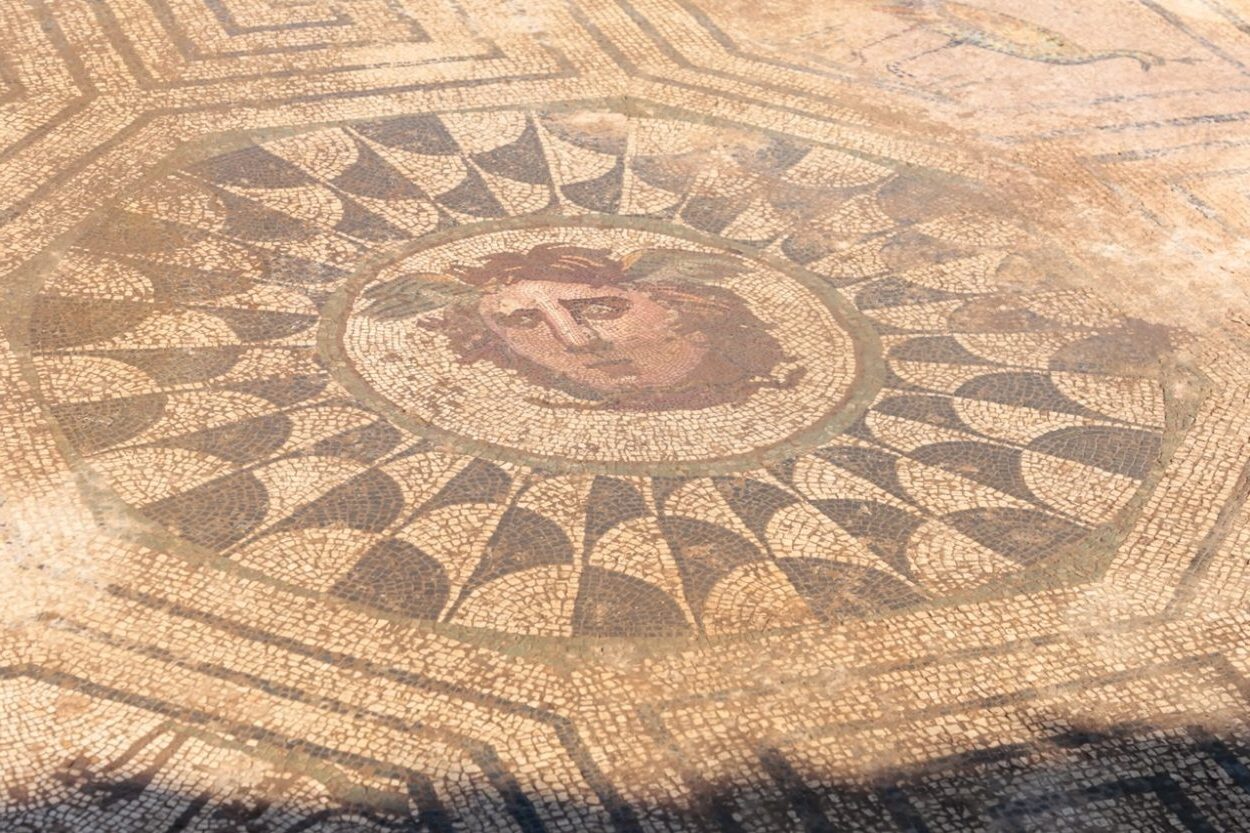
What makes the Huerta De Otero Medusa Mosaic so special? This ancient artwork, discovered in Spain, is a stunning example of Roman craftsmanship. Dating back to the 1st century AD, the mosaic features a mesmerizing depiction of Medusa, the mythical Gorgon with snakes for hair. Intricate details and vibrant colors bring the myth to life, showcasing the artistic skills of the time. Found in the remains of a Roman villa, this mosaic offers a glimpse into the luxurious lifestyles of ancient Romans. Preserved through centuries, it stands as a testament to the enduring allure of classical art and mythology.
Key Takeaways:
- The Huerta De Otero Medusa Mosaic, discovered in Spain, showcases Roman art and culture, offering a captivating glimpse into ancient history and mythology.
- This well-preserved mosaic of Medusa not only reflects Roman influence on Spanish culture but also serves as an educational tool, inspiring new discoveries and interdisciplinary research in modern archaeology.
The Discovery of Huerta De Otero Medusa Mosaic
The Huerta De Otero Medusa Mosaic is a captivating archaeological find that has intrigued historians and art enthusiasts alike. Unearthed in Spain, this mosaic offers a glimpse into ancient Roman artistry and culture.
-
Location: The mosaic was discovered in the town of Mérida, Spain, which was once a significant Roman settlement known as Emerita Augusta.
-
Date of Discovery: Archaeologists uncovered the mosaic in 2019 during an excavation project aimed at exploring Roman ruins.
-
Size: Measuring approximately 30 square meters, the mosaic is one of the largest Roman mosaics found in Spain.
-
Depiction: The central figure of the mosaic is Medusa, a mythical creature from Greek mythology known for her snake-covered head and petrifying gaze.
-
Condition: Despite being buried for centuries, the mosaic is remarkably well-preserved, with vibrant colors and intricate details still visible.
Artistic and Historical Significance
The Huerta De Otero Medusa Mosaic is not just an artistic masterpiece; it also holds significant historical value, shedding light on Roman life and beliefs.
-
Roman Influence: The mosaic reflects the Roman influence on Spanish culture, showcasing their artistic techniques and mythological themes.
-
Materials Used: Crafted from small pieces of colored stones and glass, known as tesserae, the mosaic demonstrates the advanced craftsmanship of Roman artisans.
-
Symbolism: Medusa's image was often used in Roman art as a protective symbol, believed to ward off evil.
-
Public Display: The mosaic was likely part of a public building or a wealthy individual's home, indicating its importance in Roman society.
-
Cultural Exchange: The presence of Greek mythology in Roman art highlights the cultural exchange between these ancient civilizations.
Archaeological Techniques and Preservation
The discovery and preservation of the Huerta De Otero Medusa Mosaic involved advanced archaeological techniques and meticulous care.
-
Excavation Methods: Archaeologists used careful excavation methods to ensure the mosaic was not damaged during its unearthing.
-
Documentation: Detailed documentation, including photographs and sketches, was made to record the mosaic's condition and details.
-
Conservation Efforts: Conservationists employed modern techniques to preserve the mosaic, ensuring it remains intact for future generations.
-
Public Access: Efforts are being made to make the mosaic accessible to the public, allowing people to appreciate this ancient artwork.
-
Educational Value: The mosaic serves as an educational tool, helping people learn about Roman art and history.
The Myth of Medusa
Medusa's story is one of the most fascinating myths from ancient Greece, and her depiction in the mosaic adds another layer of intrigue.
-
Origins: Medusa was one of the Gorgon sisters in Greek mythology, known for her ability to turn people to stone with her gaze.
-
Transformation: According to myth, Medusa was transformed into a monster by the goddess Athena as punishment.
-
Perseus: The hero Perseus famously beheaded Medusa, using her head as a weapon to defeat his enemies.
-
Symbol of Protection: In Roman culture, Medusa's image was often used as a protective symbol, believed to ward off evil and danger.
-
Artistic Interpretations: Medusa has been depicted in various forms of art throughout history, from ancient mosaics to modern sculptures.
The Impact on Modern Archaeology
The discovery of the Huerta De Otero Medusa Mosaic has had a significant impact on modern archaeology, providing new insights and sparking further research.
-
New Discoveries: The mosaic has led to new discoveries in the area, as archaeologists continue to explore the site.
-
Technological Advances: The use of advanced technology, such as ground-penetrating radar, has improved the accuracy and efficiency of archaeological excavations.
-
Interdisciplinary Research: The mosaic has prompted interdisciplinary research, involving historians, art experts, and scientists.
-
Cultural Heritage: The mosaic is now considered an important part of Spain's cultural heritage, highlighting the country's rich history.
-
Tourism: The mosaic has attracted tourists and history enthusiasts, boosting local tourism and economy.
Future Prospects and Research
The Huerta De Otero Medusa Mosaic continues to be a subject of interest for researchers and historians, with many future prospects and research opportunities.
-
Further Excavations: Ongoing excavations in the area may reveal more Roman artifacts and structures.
-
Digital Reconstruction: Researchers are working on digital reconstructions of the mosaic, allowing people to view it in its original context.
-
Comparative Studies: Comparative studies with other Roman mosaics can provide deeper insights into Roman art and culture.
-
Publications: Numerous academic papers and publications have been written about the mosaic, contributing to the field of archaeology.
-
Exhibitions: Plans are underway to include the mosaic in exhibitions, both in Spain and internationally.
The Legacy of Roman Art
The Huerta De Otero Medusa Mosaic is a testament to the enduring legacy of Roman art and its influence on subsequent generations.
-
Artistic Techniques: The mosaic showcases the advanced artistic techniques developed by Roman artisans.
-
Cultural Influence: Roman art has influenced various cultures throughout history, leaving a lasting impact on art and architecture.
-
Preservation of History: The mosaic helps preserve the history and culture of ancient Rome, allowing future generations to learn from it.
-
Inspiration for Artists: Modern artists continue to draw inspiration from Roman mosaics, incorporating similar techniques and themes in their work.
-
Educational Resource: The mosaic serves as a valuable educational resource, helping people understand the complexities of Roman art and culture.
Final Thoughts on the Huerta De Otero Medusa Mosaic
The Huerta De Otero Medusa Mosaic offers a fascinating glimpse into ancient Roman artistry. Discovered in Spain, this mosaic showcases the intricate craftsmanship and cultural significance of the Medusa myth. With its vibrant colors and detailed design, it stands as a testament to the skill of Roman artisans. The mosaic not only highlights the importance of mythology in Roman society but also provides valuable insights into their daily lives and artistic preferences. For history buffs and art enthusiasts alike, the Huerta De Otero Medusa Mosaic remains a captivating piece of ancient history. Its preservation and study continue to enrich our understanding of the past, making it a significant artifact worth exploring. Whether you're a student, a historian, or just curious about ancient art, this mosaic is a remarkable example of Roman heritage.
Frequently Asked Questions
Was this page helpful?
Our commitment to delivering trustworthy and engaging content is at the heart of what we do. Each fact on our site is contributed by real users like you, bringing a wealth of diverse insights and information. To ensure the highest standards of accuracy and reliability, our dedicated editors meticulously review each submission. This process guarantees that the facts we share are not only fascinating but also credible. Trust in our commitment to quality and authenticity as you explore and learn with us.


